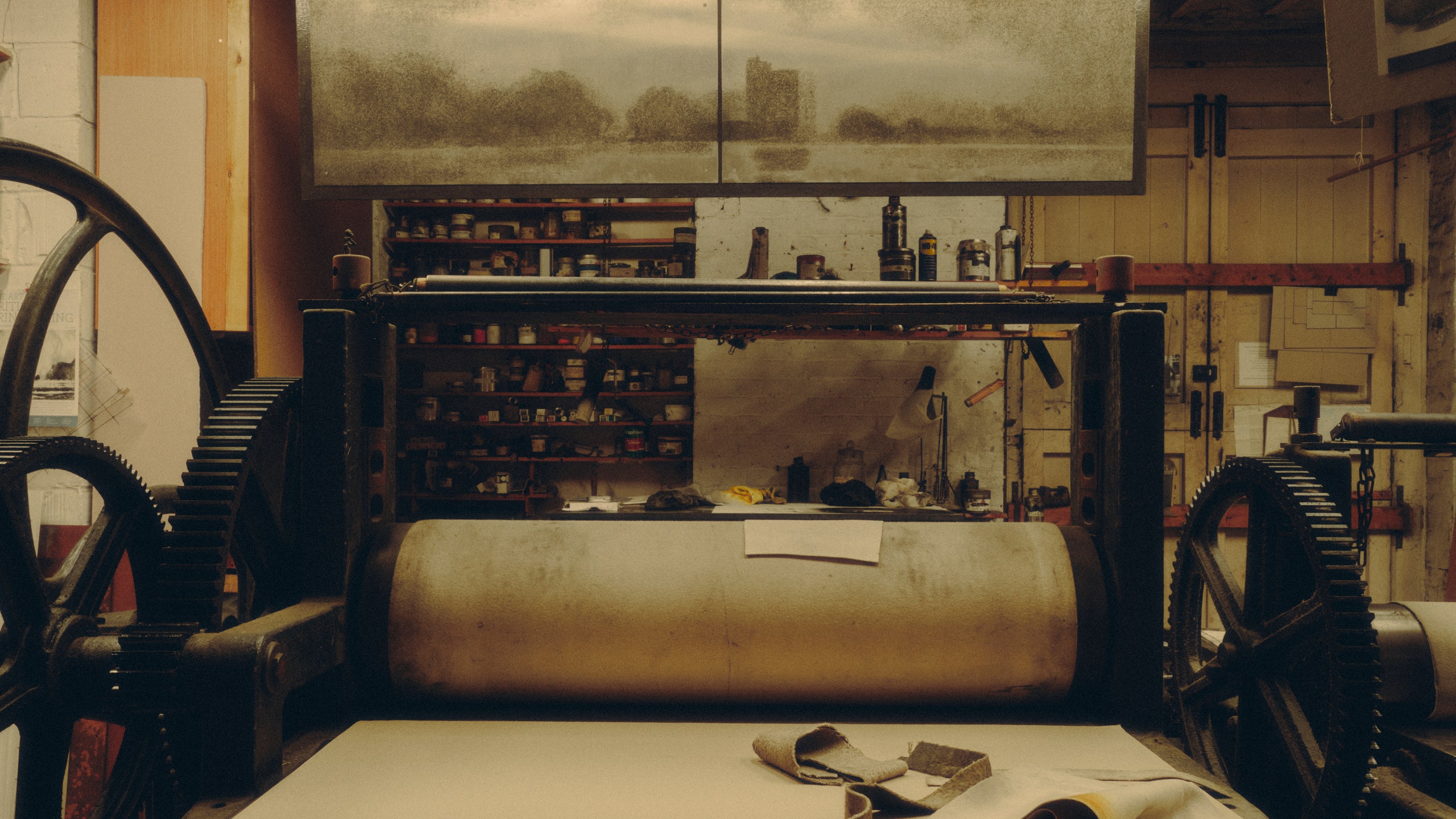Norman Ackroyd does not immediately strike you as a city dweller. The master printmaker has made a career out of exploring the wildest corners of the country, embarking on weeks-long boat trips to call upon the great stacks of St Kilda, or the dramatic clifftops of Hermaness. He reimagines these scenes in stunning grades of monochrome, made possible through his exceptional command of the etching process known as aquatint. Sea spray, rock forms and flocks of birds are all rendered in deft marks that are charged with an elegant, potent beauty.
It was a surprise, then, to arrive at his studio, a former leather warehouse just off Bermondsey Street. A century ago the area was a nexus of tanneries and workshops, and after various evolutions is now a cosmopolitan hub of galleries, bars and eateries. Ackroyd arrived in the early 1980s when the street was still regarded by many as rough, and made his rundown four-storey property into a fully equipped printing studio, archive and family home.
The urban set-up has proved a mainstay for an artist who produces work relentlessly. His forensic knowledge of etching is legendary among printers the world over, and his skills are often in high demand, particularly when it comes to setting up complex printing presses, not to mention preparing the volatile baths of acid used in the process.
His basement studio is something many art schools can now only dream of, as equipment is sold off and expertise falters amid budget cuts and moves to digital. Here, shelves of copper sheets, hot plates used for inking, and reams of paper, all surround two enormous roller presses. These are the beating heart of the entire building – objects both utilitarian and stunning – and form what he refers to as his ‘printing factory’.
Ackroyd is acutely aware of the issues surrounding arts education in this country, particularly processes that demand space, time and specialist knowledge. He has been an educator for much of his life and counts himself among the fortunate postwar generation who studied for free. This is why he has taken it upon himself to set up his eponymous foundation, with his daughter, the composer Poppy Ackroyd. It will offer financial support to students embarking on an array of careers, be it in the visual arts, poetry or music. The expansive remit reflects his own beliefs in the value of all kinds of creativity.
To raise funds, he is selling a range of works at this year’s London Original Print Fair, drawn from his sizeable and fastidiously organised archive. On entering this bright, airy space from the relative gloom of the workshop, one understands the sheer breadth of his seven-decade career. Leafing through coded files and boxes, he stumbles on a print that he thought long lost; ‘you always find a surprise in here,’ he says, laughing.
It is on the top-floor living quarters that one gets a full sense of Ackroyd’s life and work, which seem inextricable. A Bechstein grand piano once winched up via crane is flanked by a museum-worthy selection of works on paper. Prints by Francisco de Goya, Paula Rego, Henri Matisse and Marc Chagall are displayed alongside children’s crayon sketches and a charcoal drawing by his mother. All of them have a story to tell.
The same goes for many objects that adorn the space. An astonishing mechanical hoist complete with hefty iron chains is a reminder of the building’s former use, and it now operates as an elaborate room divider. It is covered in paintbrushes (of which many more are organised on bespoke floating shelves) and ephemera including corks, feathers and stones that are arranged with the care of a seasoned traveller and collector.
Even the radiators have auspicious beginnings. They were chosen on the back of those installed at Charleston farmhouse. Ackroyd was a regular visitor back when it belonged to the artist Cyril Reason, offering his expertise to install an etching press in Vanessa Bell’s former studio, in another act of generosity and collaboration that has long defined his work.
Other delightful assemblages include makeshift bookshelves devised from wine crates, trolleys stuffed with art materials and a draughtsman’s board pinned with watercolours that he paints from a huge plan chest in the middle of the living room. Despite the abundance of stuff, a sense of calm permeates, never more so than on the roof terrace, with daffodils in full bloom. ‘I absolutely love it here. You get up in the morning and stand four floors above the street – all you can hear is birdsong,’ Ackroyd says. This inner-city home, it seems, provides all the tranquillity he needs.
Looking out over the skyline, I suggest it must have changed exponentially in the time he has lived here, but the artist is not one to dwell on the past. Instead, he points to the gloriously garish façade of the neighbouring Fashion and Textile Museum, founded by Zandra Rhodes, who lives above (WoI April 2023). ‘She joined me on my last trip out to the Atlantic and did a load of drawings in bright pink felt pen,’ he recalls. The most unexpected tales can be found everywhere you look.
London Original Print Fair is returning to Somerset House for its 39th edition, from 21 to 24 March. Details: londonoriginalprintfair.com
